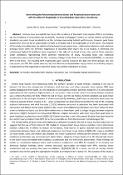Options
Determining the relationship between linear and rotational acceleration and MPS for different magnitudes of classified brain injury risk in ice hockey
Date Issued
2015-09-11
Date Available
2017-07-26T14:17:53Z
Abstract
Helmets have successfully decreased the incidence of traumatic brain injuries (TBI) in ice hockey, yet the incidence of concussions has essentially remained unchanged. Current ice hockey helmet certification standards use peak linear acceleration as the principal measuring helmet performance, however peak linear acceleration may not be an appropriate variable to evaluate risk at all magnitudes of brain injury. The purpose of this study is to determine the relationship between linear acceleration, rotational acceleration and maximum principal strain (MPS) for different magnitudes of classified brain injury risk in ice hockey. A helmeted and unhelmeted Hybrid III headform were impacted to the side of the head at two sites and at three velocities under conditions representing three common mechanisms of injury. Resulting linear and rotational accelerations were used as input for the University College Dublin Brain Trauma Model (UCDBTM), to calculate MPS in the brain. The resulting MPS magnitudes were used to separate the data into three groups: low risk; concussion; and TBI. The results demonstrate that the relationship between injury metrics in ice hockey impacts is dependent on the magnitude of classified injury risk and the mechanism of injury.
Type of Material
Conference Publication
Publisher
International Research Council on the Biomechanics of Injury (IRCOBI)
Start Page
168
End Page
179
Language
English
Status of Item
Peer reviewed
Journal
2015 IRCOBI Conference Proceedings
Conference Details
International Research Council on Biomechanics of Injury Conference, Lyon, France, 9-11 September 2015
This item is made available under a Creative Commons License
File(s)
Loading...
Name
Clark_et_al_2016_-_Determining_the_Relationship.pdf
Size
1.11 MB
Format
Adobe PDF
Checksum (MD5)
71e30ec11b3e539eb67945b751e830f0
Owning collection